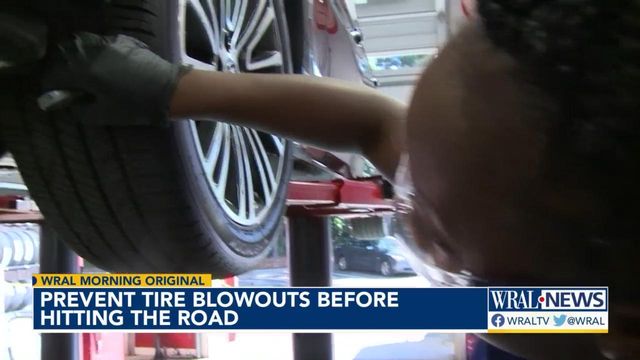Car care experts warn summer heat can increase the risk of tire blowouts
Now is the time to check your tires before you leave on a road trip for vacation or just down the street to your nearest grocery store. The summer heat can increase the risk of tire failure as well as the accidents they can cause.
That travel threat is part of what keeps car repair centers like AAA in Cary busy. Once each car is boosted up on the lift, service team members like Sierra Curry start with a tire inspection. She looks for signs of objects in the tire and any indications of leaks, punctures or worn out treads.
"So right here we have a tire that was visibly bad. We have secondary rubber and cords that are showing," explained Curry. She says the customer brought the car in for an oil change, unaware of the tire issue.
Another customer’s tire in the garage showed signs of a close call on the road. "The traction on the tire caused the tire to skip and slide, and it obviously hit some kind of object on the road which caused it to hit right here and blow out that tire," said AAA’s Michael Koziatek.
The heat of summer can lead to an increase of potentially life-threatening tire blowouts. Shrinking tire treads, poor alignment and suspension issues are often the cause.
AAA regional manager Justin Lanterman explained after one blowout occurred. "The braking distance was probably horrible on this tire because tires do the majority of the braking."
Factors that can lead to blowouts include low tire pressure, weak spots in the tire wall, poor road conditions or a rapid change in temperature.
Regular tire inspections, especially before a long trip, reduce the risk.
Koziatek said an inspection includes a routine series of tire tests "to make sure that it’s at the right tire pressure and also to make sure the tires are actually in good shape and condition."
Many people don’t know what tire pressure they should maintain. Curry says don’t look at the tire itself for that information, although there is a tire pressure embossed on tires. "That’s the maximum pressure you want to put in your vehicle," said Curry.
She says owners should go by the recommended tire pressure typically found on a panel inside the driver’s side door. "And it will indicate the front tire and the rear tire pressure," said Curry.
Koziatek says he’s seen countless tires that are no longer road-worthy. "If you go to a retail store, you look around the parking lot? You see a ton of these tires all day long."












